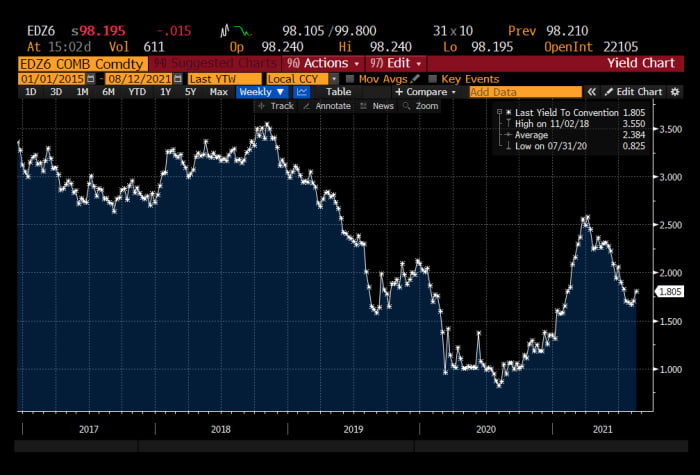This post was originally published on this site
Eurodollar futures are telegraphing an outlook that suggests the U.S. economy may still be struggling to recover five years from now — weighed down by a pandemic that won’t go away.
That’s reflected in Eurodollar contracts priced for a Federal Reserve policy interest rate still below 2% in 2026, and a similar pattern can be seen in forward interest-rate swaps linked to the fed funds target rate, some analysts say.
The moves reflect a worrisome risk that the economy continues struggling despite a widespread vaccine rollout, and the concern that the Federal Reserve misses its long-run fed funds projection of 2.5%, according to portfolio manager R.J. Gallo of Pittsburgh-based Federated Hermes Inc., which oversees more than $645 billion in assets. That ‘s not the base-case view of his firm, which is more optimistic about future economic growth prospects and interest rate trajectories than what’s implied in the 2026 contract, he says.

Image shown of the implied rate in the 2026 Eurodollar futures contract. Bloomberg
“The virus depresses nominal rate expectations years out because it remains an ongoing source of growth uncertainty, and consigns bond yields to trade at a lower range for a longer period of time,” Gallo said in a phone interview with MarketWatch. “The virus is so unpredictable that we could just have more and more variants, and it becomes a structural source of uncertainty and a headwind for global economic growth.”
Eurodollar futures are a preferred tool of traders for expressing views on future interest-rate moves.
The market’s current sentiment is a turnabout from much of the past year, when the implied rate of the 2026 contract started soaring from 0.83% last July to a bit above 2.5% in March, powered by the possibility of a stimulus- and vaccine-fueled resurgence of U.S. growth potential. Even after the rate started to slip from 2.5%, it still remained above the 2% level for roughly three months before finally dipping to its current level around 1.8% — signaling that the U.S.’s massive surge in growth from the depths of the pandemic will be temporary.
The implied rate on the contract started falling below 2% around June, as COVID-19’s delta variant began to spread.
Before they can hike interest rates, Federal Reserve policy makers need to begin the process of tapering $120 billion in monthly purchases of Treasurys and mortgage-backed securities — and the first rate increases aren’t being penciled in until 2023.
Fed officials are currently in somewhat of dilemma because the two prongs of their dual mandate — maximum employment and stable prices — are moving at different speeds. While the unemployment rate has fallen, millions of Americans are still unemployed despite record job openings, at the same time U.S. inflation readings remain high, even after moderating in July.
Read: Still-high U.S. inflation leaves Federal Reserve with little room for error
“The market always prices in what’s next, and I do think the recovery is going to be in fits and starts, due to the virus, and could take a couple of years,” Scott Buchta, head of fixed income strategy at Brean Capital, said via phone.
“The bar to taper the Fed’s bond purchases is lower than the bar to raise rates, and the market thinks the Fed is going to err on the side of caution by keeping its policy rate lower for longer. However, we believe that, longer term, the market may be underestimating the path of rates going forward, especially if inflation remains at 3% or higher a few years out.”

